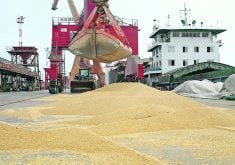The EU supplies 60 percent of the U.K.’s pork needs, but greater tariffs would force it to look elsewhere, such as Canada
As the battle over the United Kingdom’s messy divorce from the European Union continues, Canada and the United States could emerge as major suppliers of pork to the U.K. in a no-deal Brexit scenario.
While the EU supplies 60 percent of pork consumption in the U.K., greater tariffs imposed in a no-deal situation would force the U.K. to look elsewhere to a non-EU supplier.
EU pork is typically cheaper than British pork, which attracts a premium because it is more desirable with some supermarkets selling only fresh pork produced in the U.K.
Read Also

Flax sector sees omega-3 opportunity
SASKATOON — A global shortage of omega-3 oils could be an opportunity for the flax sector, says an industry official….
In addition, about 40 percent of British production is outdoor bred and that also attracts a higher price.
If higher tariffs are imposed on EU pork entering the U.K., it will become more expensive and other global suppliers could then become more price competitive.
The EU, and so the U.K., imposes tariffs of $1.42 per kilogram on pork imports from non-EU countries. This effectively eliminates competition from the rest of the world. However, under a no-deal Brexit, key global suppliers would face the same average 15 cents per kg tariff as the U.K.’s current EU suppliers.
According to the Agriculture, Horticulture Development Board’s pork division (AHDB Pork), the U.S., Canada and Chile are listed as able to supply raw pork to the EU and it is expected that these licences would roll over to the U.K. post-Brexit.
Pork prices in the U.S. and Canada are typically lower than British prices because of lower production costs.
Last year prices were particularly weak, averaging about US$1.29 per kg in the U.S. and about $1.21 per kg in Canada.
The current EU tariff levels make Canadian and U.S. pork prices about 45 cents per kg more expensive than British prices.
In contrast, the new U.K. average tariff would leave Canadian prices last year 51 cents per kg lower than British prices and U.S. prices 43 cents per kg lower than British prices.
Estimates suggest shipping product from the EU to the U.K. is not significantly cheaper than transporting from North America.
This means that on average, EU prices would be above British prices and therefore uncompetitive, and Canadian and U.S. pork would be even more price competitive than EU pork is now.
“Of course, the above analysis is a simplification. In reality, trade flows will depend on the price of individual cuts as well as product suitability,” AHDB Pork said.
“Producers in both the U.S. and Canada can use ractopamine in pig production, although not all do, and this pork could not be imported into the U.K.
“Product meeting the required sanitary standards will probably attract above average prices, and so the prices on offer initially may not be quite as low as suggested above.
“It is unlikely that very much is going to change overnight, and the tariff themselves are designed to be temporary. Logistically, importers are also unlikely to switch suppliers immediately in the event of a no-deal Brexit.
“However, if in the longer-term there is still no deal, this increases (Great Britain) exposure to the global pork market, meaning British pig prices could be more volatile, and generally lower, in the future.”















